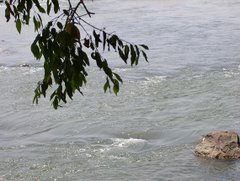What's common among them?







This month, the World Conservation Union (IUCN) released the Red List of Threatened Species for 2007. The western lowland gorilla, the freshwater dolphin and the Egyptian vulture are some of the latest additions to the list of endangered animals. Since 2006, the annual assessment of the planet's imperiled wildlife has grown by more than a thousand species and now totals 41,415. Many great apes end up on the list, as their habitat is continually under threat from human activities. The Western lowland gorilla populations in central Africa have collapsed due to the commercial bushmeat trade and the Ebola virus; and in Indonesia, orangutans are critically endangered because of forest logging and clearing land for palm oil plantations.
The 'baiji', or Chinese river dolphin— deemed "functionally extinct" by a team of scientists in December 2006—has been downgraded from "endangered" to "critically endangered (possibly extinct)" on the IUCN's 2007 Red List. Populations of the light blue-gray animal, which lives in China's polluted Yangtze River, have plummeted over the last 30 years. A possible sighting in August 2007 is currently being investigated by Chinese scientists, but even if one or two dolphins are found, the baiji is almost certainly doomed. “Freshwater dolphins are very vulnerable, because rivers tend to be heavily used by humans and there is nowhere else for the dolphins to go,” says Caroline Pollock, a Red List program officer.
The Egyptian vulture, a new addition to IUCN's 2007 Red List, has declined along with many other vulture species. Five species of vulture, including the Egyptian, have been reclassified to a higher threat level since 2006. Asian vultures have declined rapidly over the last eight years due to the use of a livestock drug called diclofenac. African vultures are struggling due to habitat loss, a lack of food, and collisions with power lines. The scavengers are also being killed by insecticide-laden carcasses, which have been deliberately baited to poison livestock predators such as hyenas.
Mexico's Santa Catalina Island rattlesnake has been classified as critically endangered on the 2007 IUCN Red List. The snake, found on just one island, sports highly desirable patterned skin that has made it a collector's item for hunters. New reptile surveys are revealing the fragile nature of many reptile populations. For instance, a major survey of North American reptiles has bumped up the region's Red List reptile species to a total of 738. The main culprit behind their decline is habitat loss due to expanding cities.“Unlike birds and mammals, we haven't assessed all the reptiles on the planet,” Pollock added.
The Banggai cardinal fish's popularity as a pet for the home aquarium has landed it on the 2007 IUCN Red List. In the wild, the striped fish is only found in the Banggai Archipelago off Indonesia. Human pressures such as the aquarium trade are the main reason for the fish's decline, with habitat loss and climate change also posing major threats. Fish stocks are in free-fall all over the world, both from overfishing and the aquarium trade. Scientists estimate current extinction rates are at least a hundred to a thousand times higher than natural rates.
Reptiles such as the gharial are becoming more prominent on the IUCN's Red List each year. Despite its fearsome appearance and lengths of up to 19 feet (6 meters), the Indian gharial is not a man-eater and prefers to eat fish. Its long, thin snout, which makes it easily distinguishable from a crocodile, also allows it to quickly capture fish. Habitat loss and poaching is driving this animal toward extinction.
For the first time, corals are added to the Red List. A recent scientific survey on the Galápagos Archipelago has added ten corals to the list, including the Floreana coral. In the 1980s, frequent El Niño weather patterns—which made ocean temperatures fluctuate—likely led to the poor state of the Galápagos corals. Some scientists worry that global warming may make El Niño events more regular and prevent corals from recovering. Until recently, scientists had not properly assessed the health of the world's tropical corals. Coral reefs in the Indian and Pacific Ocean, for example, are vanishing faster than rain forests and scientists estimate that human activities such as pollution, global warming and sedimentation could kill 30 percent of reefs in the next three decades.
Source: The National Geographic
Source: The National Geographic













No comments:
Post a Comment